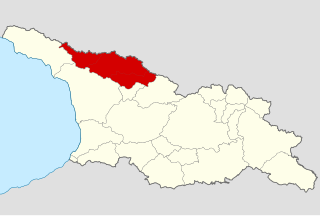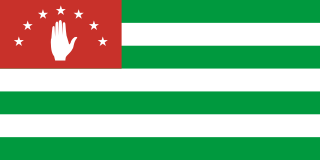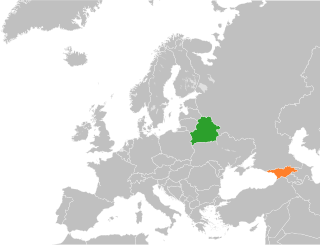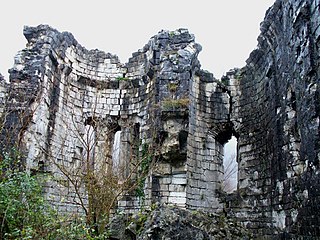| Tsebelda Fortress | |
|---|---|
| New Athos, Abkhazia, Georgia | |
| Coordinates | 43°01′30″N41°16′00″E / 43.02500°N 41.26667°E |
Tsebelda fortress is a Late Antique/Early Medieval fortification near the village of Tsebelda, in the eponymous valley, in Abkhazia, Georgia.
| Tsebelda Fortress | |
|---|---|
| New Athos, Abkhazia, Georgia | |
| Coordinates | 43°01′30″N41°16′00″E / 43.02500°N 41.26667°E |
Tsebelda fortress is a Late Antique/Early Medieval fortification near the village of Tsebelda, in the eponymous valley, in Abkhazia, Georgia.
The Tsebelda fortress is an architectural complex consisting of ruined towers, Christian chapels, a palace, necropolis, and several other structures. It is erected on two cliffs more than 400 m high above the Kodori river gorge. The extant structures at Tsebelda are identified with the Tsibilium/Tzibile of the Classical authors, such as Procopius of Caesarea. It appears to have been a chief fortress in Apsilia, a vassal principality of the Lazic kingdom in the 6th century. [1] [2] The fortress dominated the confluence of three major routes from the northern Eurasian steppe on their way to the Black Sea. Around 550, during the Lazic War, the Laz notable Terdetes betrayed his king Gubazes and handed the fortress of Tzibile over to the Persians. [3] The Apsilians retook the fort, but refused to accept Lazic rule until persuaded to do so by the Byzantine general John Guzes. [4] [5]
The law of Georgia treats the monument as part of cultural heritage in the occupied territories. [6] In January 2017, Georgia, followed by the United States Mission to the OSCE, accused the Russian military of having put the historical site of Tsebelda under risk of destruction after a nearby located 19th-century Polish cemetery and a church were demolished in order to build a shooting range. [7] [8] Officials from breakaway Abkhazia confirmed the damage during a firing range construction but did not elaborate further details. [8] The Russian Defense Ministry denied any involvement. [8]

The Kingdom of Lazica, sometimes called Lazian Empire, was a state in the territory of west Georgia in the Roman period, from about the 1st century BC. Created as a result of the collapse of the kingdom of Colchis and the gaining of independence by the tribal-territorial units included in it in 131 AD.

Svaneti is a historic province in the northwestern part of Georgia. Running along the Greater Caucasus range, Svaneti is one of the most mountainous regions of Georgia. It is largely inhabited by the Svans, an ethnic subgroup of Georgians.

The Abkhazia conflict is a territorial dispute over Abkhazia, a region on the eastern coast of the Black Sea in the South Caucasus, at the intersection of Eastern Europe and Western Asia. The conflict involves Georgia, the Russian Federation and the Russian-backed self-proclaimed Republic of Abkhazia, which is internationally recognised only by Russia, Venezuela, Nicaragua, Nauru, and Syria; Georgia and all other United Nations members consider Abkhazia a sovereign territory of Georgia. However, as of 2023, Georgia lacks de facto control over the territory.

The Kingdom of Abkhazia was a medieval feudal state in the Caucasus which was established in the 780s. Through dynastic succession, it was united in 1008 with the Kingdom of the Iberians, forming the Kingdom of Georgia.

The history of Abkhazia, a region in the South Caucasus, spans more than 5,000 years from its settlement by the lower-paleolithic hunter-gatherers to its present status as a partially recognized state.

Foreign relations exist between Armenia and Georgia. Both countries were former Soviet republics of the Soviet Union. Both countries' governments have had generally positive relations, but there have also been some problems. Both countries are members of the Council of Europe, the European Political Community, and the EU's Eastern Partnership and Euronest Parliamentary Assembly.

The nation of Georgia was first unified as a kingdom under the Bagrationi dynasty by the King Bagrat III of Georgia in the early 11th century, arising from several successor states of the ancient kingdoms of Colchis and Iberia. The Kingdom of Georgia flourished during the 11th and 12th centuries under rulers such as King David IV the Builder and Queen Tamar the Great. The kingdom fell to the Mongol invasion by 1243, and after a restoration under George V the Brilliant it fell again to the Timurid Empire in 1403. By 1490, Georgia was fragmented into several petty kingdoms and principalities, which throughout the Early Modern period struggled to maintain their autonomy against Ottoman and Iranian domination until Georgia was finally annexed by the Russian Empire in the 19th century. After a brief period of independence as Democratic Republic of Georgia, the country soon ended up being a Soviet Republic until the dissolution of the Soviet Union. The current republic of Georgia has been independent since 1991.

Abkhazia, officially the Republic of Abkhazia, is a partially recognised state in the South Caucasus, on the eastern coast of the Black Sea, at the intersection of Eastern Europe and West Asia. It covers 8,665 square kilometres (3,346 sq mi) and has a population of around 245,000. Its capital and largest city is Sukhumi.

Before 1918, both Belarus and Georgia were part of the Russian Empire and both were part of the USSR until 1991. Both countries established diplomatic relations in 1992.

The area of Georgia was under Roman control between the 1st century BC and the 7th century AD. This control varied by time and was intermittent over the kingdoms of Colchis and Iberia in the Caucasus region. These kingdoms roughly correspond to some of the western and eastern parts of modern Georgia.
Tsebelda culture is a late antiquity to early medieval archaeological culture in the territory of the Apsilae or Tsebelda tribe, located in Abkhazia, Georgia on the Black Sea coast. The culture is known mainly from excavation of burial sites, starting in 1959, which yielded a large collection of artefacts.

Before the 10th-century unification of the country by the Bagrationi dynasty, several Georgian states subsisted between the Roman Empire on the west and the Sassanid Empire on the east. Between the 11th and 15th centuries, the Kingdom of Georgia was a major regional power which withstood invasions by the Seljuk, Mongol and Timurid Empires before its fragmentation and submission to the Ottoman and Safavid Empires. Many Georgians fought in the armies of empires that ruled the country since the 16th century, be it the Safavids, the Russian Empire or the Soviet Union. Since 1991, independent Georgia has taken part in a number of wars; its conflict with Russia culminated in the 2008 Russo–Georgian War, and its alliance with the United States led to Georgia's participation in the Afghan and Iraq Wars.

Russian-occupied territories in Georgia are areas of Georgia that have been occupied by Russia since the Russo-Georgian War in 2008. They consist of the regions of the Autonomous Republic of Abkhazia and the former South Ossetian Autonomous Region of Soviet Georgia, whose status is a matter of international dispute.

The Gantiadi Church or Tsandripshi Church is a 6th-century three-apse basilica, located in the settlement of Gantiadi in Abkhazia, a disputed region of Georgia.

The Ambara church is located near village Miusera in the Gudauta District, Abkhazia/Georgia, on the cape of Miusera, close to the mouth of the Ambara stream. Ambara three-nave basilica represents an important example of this type of architectural monuments. Ambara church has been given the status of cultural heritage monument.

The Bzyb Church is a ruined medieval Christian church at the village of Bzyb in Gagra District, Abkhazia/Georgia, on the right bank of the Bzyb River.

The Gagra Church, also known as Abaata, is an Early Medieval Christian church at Gagra in Abkhazia, Georgia. One of the oldest churches in Abkhazia, it is a simple three-nave basilica built in the 6th century by Anchabadze dynasty. It was reconstructed in 1902.

The Church of St. Simeon the Canaanite is located near the town of New Athos in Gudauta District, Abkhazia/Georgia, dating from the 9th or 10th century. Not to be confused with St Simon the Canaanite Basilica in Psirtskha village.
Epigraphy of Abkhazia comprises all the epigraphic monuments inside Abkhazia, Georgia. They are all in Georgian, Greek, Ottoman and Latin languages. The number of the Georgian epigraphic monuments is more than 100 and they date from the 8th century AD. The Greek inscriptions are up to 22 and they mostly date before the 9th century AD. Out of the Ottoman Turkish inscriptions, the oldest one is from 1598. Out of the Georgian inscriptions up to 15 ones mention the kings of Abkhazia. About 30 inscriptions are seen on icons from Bedia, Bichvinta, Tsebelda and Ilori churches.
The Kvitouli Church of Kiachi is a ruined medieval church in the Kvitouli, Ochamchire Municipality, Abkhazia, a breakaway region of Georgia. The ruins lie on the Kiachi hill, near the modern-day village of Jgerda, 8 km south of the Kodori river, in the Tsebelda valley. The name Kvitouli refers to a historical community to which the church belonged and of which the modern-day village of Kutol/Kutoli is part.